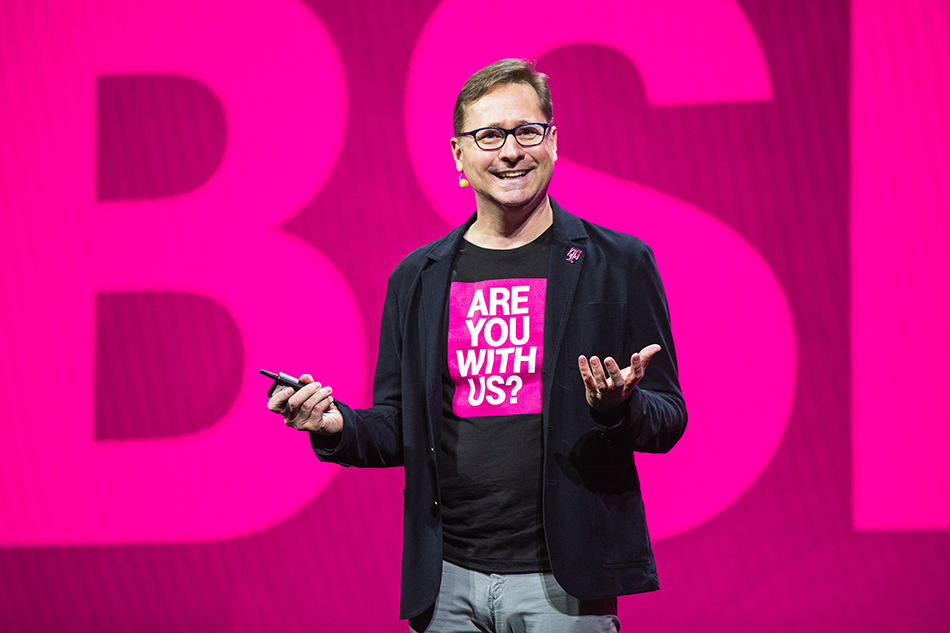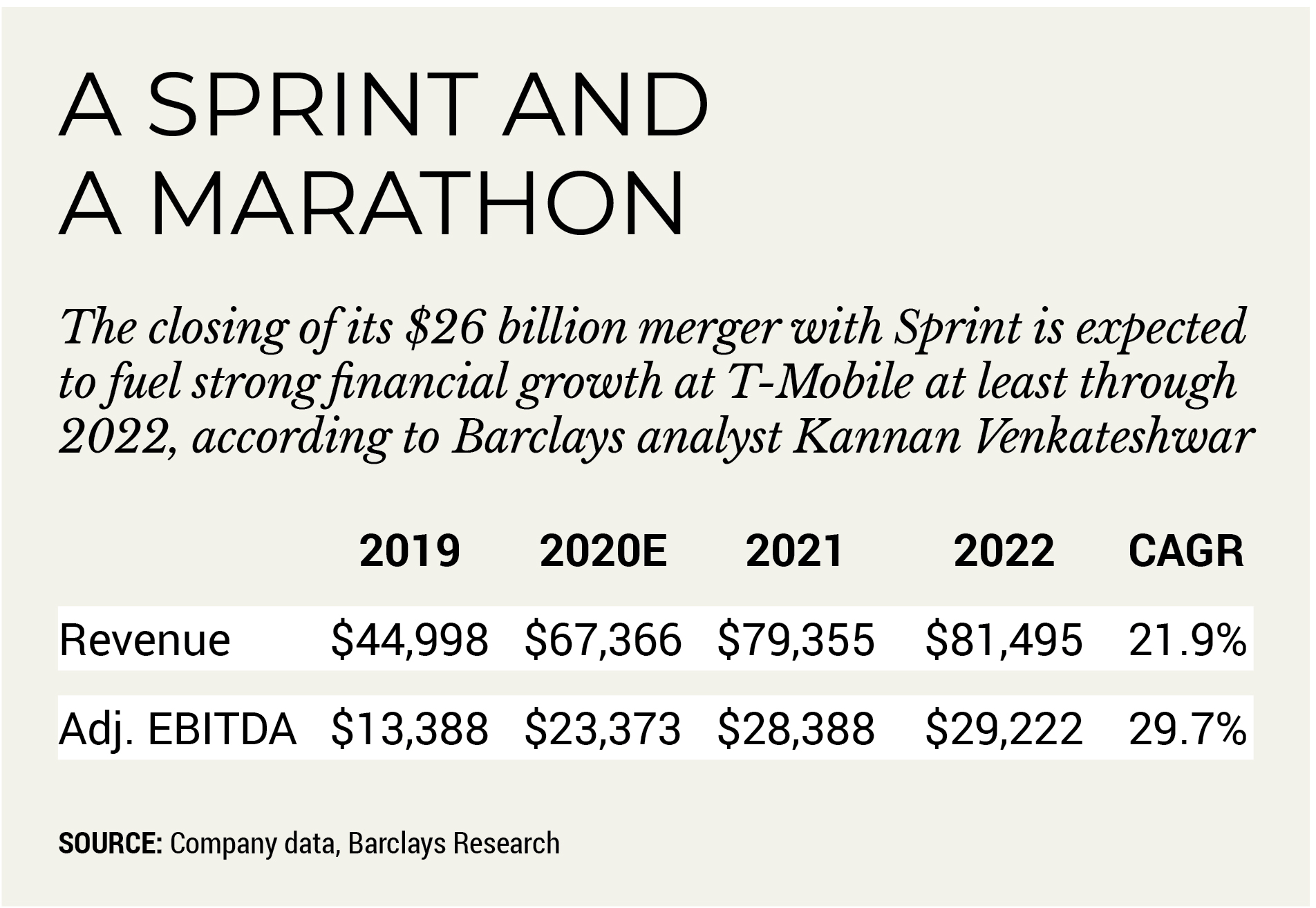Wireless Customers Sprint to T-Mobile
A little more than two months after closing its $26 billion merger with Sprint, T-Mobile reported a surprisingly robust first quarter despite setbacks associated with the COVID-19 pandemic, and according to some analysts, is positioning itself to be a wireless leader as 5G technology starts to take hold.

T-Mobile completed its Sprint merger on April 1, ending what had been a seven-year dance between the third- and fourth-largest U.S. wireless operators. T-Mobile first began exploring a Sprint merger in 2013, but didn’t make an offer until more than two years later. What followed was an 18-month federal approval process, followed by another six months battling with a handful of state attorneys general trying to block the deal. When the dust cleared, the pandemic forced T-Mobile to close its retail outlets across the country, delaying what was expected to be a major marketing push to increase awareness in the new T-Mobile brand.
“If one were so inclined, one might conclude that there is someone out there who just doesn’t want these companies combined,” MoffettNathanson principal and senior analyst Craig Moffett wrote in a note to clients. “For our part, we think New T-Mobile will be worth the wait.”
What has driven a lot of this optimism is a combination of T-Mobile’s Q1 results, which don’t include Sprint, and the promise of better days once the merger is fully integrated.
Q1 Strength
T-Mobile’s Q1 results were surprisingly good, especially during a pandemic that forced most of its retail stores to close. As the country went under lockdown, T-Mobile managed to add 777,000 new postpaid wireless subscribers in Q1, beating analysts’ consensus estimates of 752,000 additions. Though Q2 may be a bit lighter in terms of postpaid net additions — Sanford Bernstein analyst Peter Supino estimated T-Mobile would add about 100,000 postpaid customers in Q2 from the full effect of the pandemic — that is expected to turn around in Q3 and beyond.

The impact of Sprint churn won’t be known until Q2 results are released sometime in late July, but indications are that it has improved. Fueling that optimism is lower churn at T-Mobile during the first quarter; its superior network, which should increase customer satisfaction; and its aggressive rollout of 5G technology.
Multichannel Newsletter
The smarter way to stay on top of the multichannel video marketplace. Sign up below.
Churn at T-Mobile was 0.86% in Q1, well below the 0.99% most analysts expected and in line with much larger competitors AT&T and Verizon Communications.
“We believe this fact adds to our thesis that Sprint churn will improve substantially and quickly, to the benefit of growth and margins,” Supino wrote.
Supino estimates free cash flow for T-Mobile will double to $12 per share by 2023 and in the nearer term, lower churn rates will boost both consensus estimates and confidence in the merger. Supino’s own confidence in the deal is reflected in his
$124 per share 12-month price target on the stock, about 24% higher than its trading price of $100.17 per share on June 4 and 43% above its closing price when he raised his outlook on the stock.
For the year, T-Mobile shares are up about 28%.
T-Mobile has taken a different approach to 5G service than AT&T or Verizon opting for a slower-speed service (less than 1 Gigabit per second) based on the 600 Megahertz spectrum, which is easier to deploy and more adaptable to the spread-out rural areas where most of its customers live.
That’s why T-Mobile has been able to make its version of 5G available to about 215 million homes and now offers service in Detroit; St. Louis; Columbus, Ohio; and the San Francisco Bay Area, in addition to its initial rollout in New York and Philadelphia. In contrast, Verizon and AT&T have adopted millimeter wave technology that offers higher speeds (up to 10 Gigabits per second) but requires denser placement of towers. Verizon offers 5G in parts of 31 cities across the country (including New York, Los Angeles, Washington, D.C., and Denver) and expects to eventually be in front of about 30 million homes with the service. AT&T has said it is on track to deliver nationwide 5G service by the middle of the year.
While the 5G rollout continues, most Sprint customers can “roam” on T-Mobile’s 4G network — about 80% of Sprint customers have compatible handsets — and are finding the experience to be vastly better.
On a conference call to discuss first-quarter results, T-Mobile president of technology Neville Ray said about 10 million Sprint customers were using the T-Mobile network per week, or about one-third of the total postpaid subscriber base the company has with Sprint.
Sprint customer churn was a big question mark in the merger. It has historically been about twice that of legacy T-Mobile. Although it’s hard to predict what churn rates will ultimately be, T-Mobile CEO Mike Sievert said, he noted that customers leave a provider for two main reasons: network and value. In his mind, the New T-Mobile is providing both.
Value Proposition Is Key
Value, perceived or otherwise, can make a big difference in the wireless space. Cable companies like Charter Communications, Comcast and Altice USA have introduced aggressively-priced wireless offerings over the past two years and have seen spikes in customer additions. In Q1 alone, Charter added 290,000 wireless customers (nearly double that of the previous year), while Comcast added 216,000 (ahead of 170,000 in 2019). Altice USA, which launched wireless service in September 2019, added 41,000 customers.
On the T-Mobile call, Sievert suggested he expects value to drive consumer decisions as stay-at-home orders are lifted: “As the nation starts to emerge post-COVID-19, customers across the industry will likely be looking for better value in a tougher economic environment.”
Sievert added that he expects “AT&T and Verizon customers will most certainly be looking to get out from under their high monthly bills in search of a better value.”
